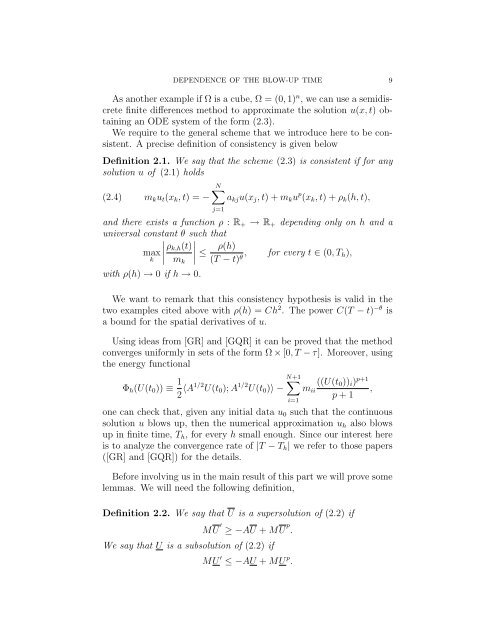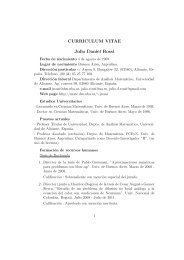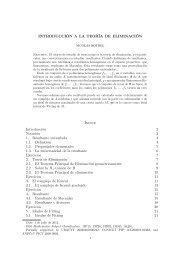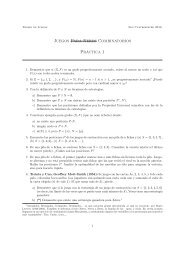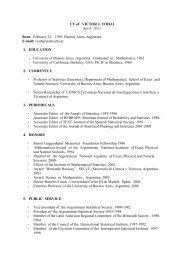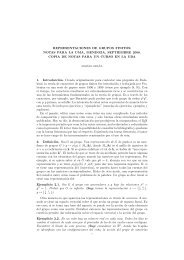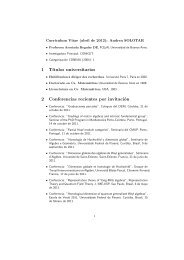Dependence of the blow-up time with respect - Universidad de ...
Dependence of the blow-up time with respect - Universidad de ...
Dependence of the blow-up time with respect - Universidad de ...
Create successful ePaper yourself
Turn your PDF publications into a flip-book with our unique Google optimized e-Paper software.
DEPENDENCE OF THE BLOW-UP TIME 9<br />
As ano<strong>the</strong>r example if Ω is a cube, Ω = (0, 1) n , we can use a semidiscrete<br />
finite differences method to approximate <strong>the</strong> solution u(x, t) obtaining<br />
an ODE system <strong>of</strong> <strong>the</strong> form (2.3).<br />
We require to <strong>the</strong> general scheme that we introduce here to be consistent.<br />
A precise <strong>de</strong>finition <strong>of</strong> consistency is given below<br />
Definition 2.1. We say that <strong>the</strong> scheme (2.3) is consistent if for any<br />
solution u <strong>of</strong> (2.1) holds<br />
N<br />
(2.4) mkut(xk, t) = − akju(xj, t) + mku p (xk, t) + ρk(h, t),<br />
j=1<br />
and <strong>the</strong>re exists a function ρ : R+ → R+ <strong>de</strong>pending only on h and a<br />
universal constant θ such that<br />
<br />
<br />
max <br />
ρk,h(t) <br />
<br />
ρ(h)<br />
k ≤ , for every t ∈ (0, Th),<br />
(T − t) θ<br />
mk<br />
<strong>with</strong> ρ(h) → 0 if h → 0.<br />
We want to remark that this consistency hypo<strong>the</strong>sis is valid in <strong>the</strong><br />
two examples cited above <strong>with</strong> ρ(h) = Ch 2 . The power C(T − t) −θ is<br />
a bound for <strong>the</strong> spatial <strong>de</strong>rivatives <strong>of</strong> u.<br />
Using i<strong>de</strong>as from [GR] and [GQR] it can be proved that <strong>the</strong> method<br />
converges uniformly in sets <strong>of</strong> <strong>the</strong> form Ω × [0, T − τ]. Moreover, using<br />
<strong>the</strong> energy functional<br />
Φh(U(t0)) ≡ 1<br />
2 〈A1/2U(t0); A 1/2 N+1 <br />
U(t0)〉 −<br />
i=1<br />
mii<br />
((U(t0))i) p+1<br />
,<br />
p + 1<br />
one can check that, given any initial data u0 such that <strong>the</strong> continuous<br />
solution u <strong>blow</strong>s <strong>up</strong>, <strong>the</strong>n <strong>the</strong> numerical approximation uh also <strong>blow</strong>s<br />
<strong>up</strong> in finite <strong>time</strong>, Th, for every h small enough. Since our interest here<br />
is to analyze <strong>the</strong> convergence rate <strong>of</strong> |T − Th| we refer to those papers<br />
([GR] and [GQR]) for <strong>the</strong> <strong>de</strong>tails.<br />
Before involving us in <strong>the</strong> main result <strong>of</strong> this part we will prove some<br />
lemmas. We will need <strong>the</strong> following <strong>de</strong>finition,<br />
Definition 2.2. We say that U is a s<strong>up</strong>ersolution <strong>of</strong> (2.2) if<br />
MU ′ ≥ −AU + MU p .<br />
We say that U is a subsolution <strong>of</strong> (2.2) if<br />
MU ′ ≤ −AU + MU p .


